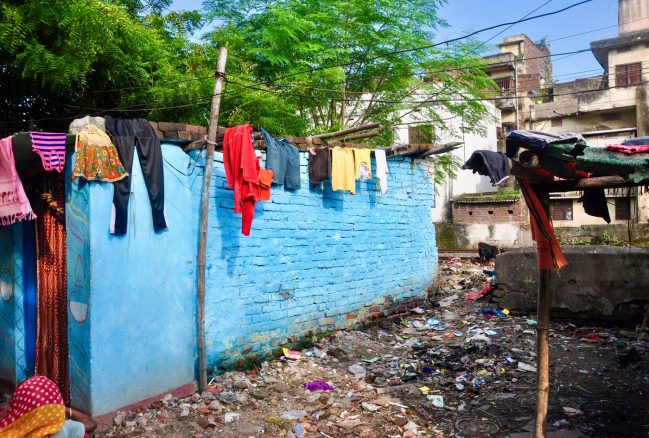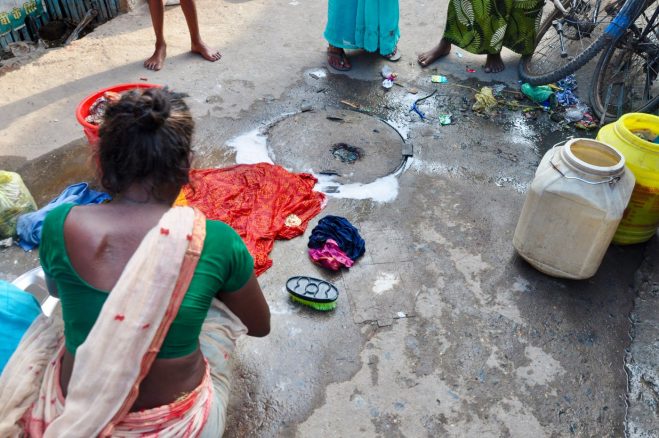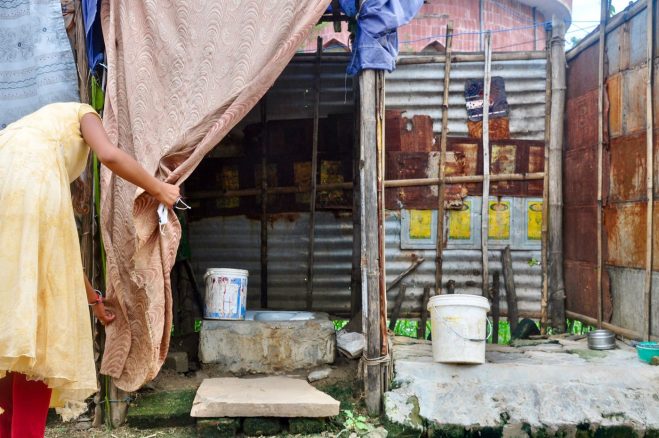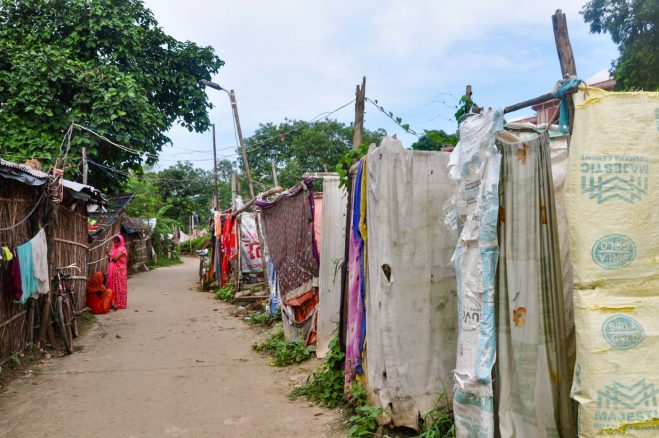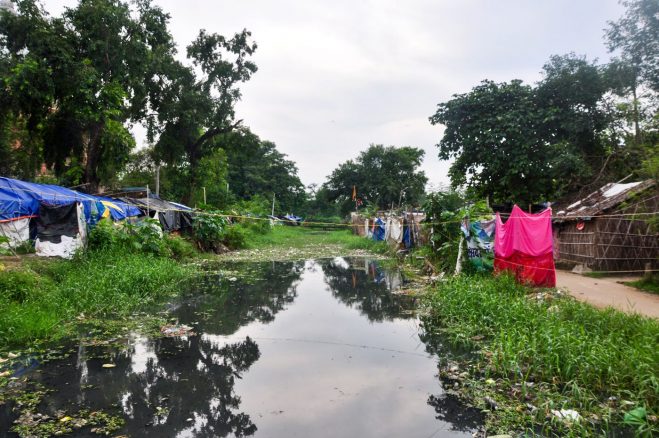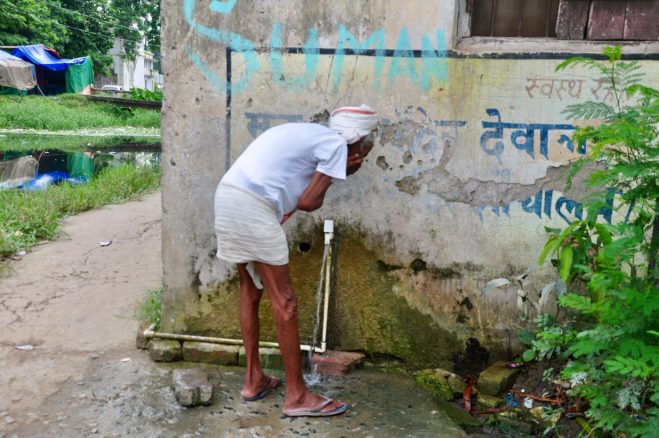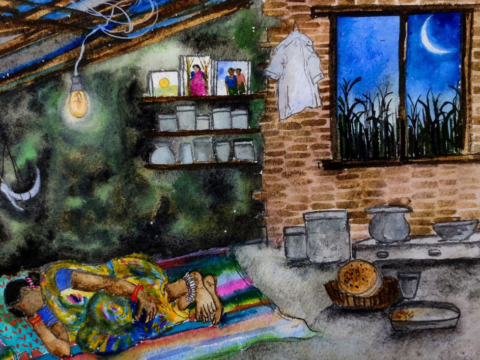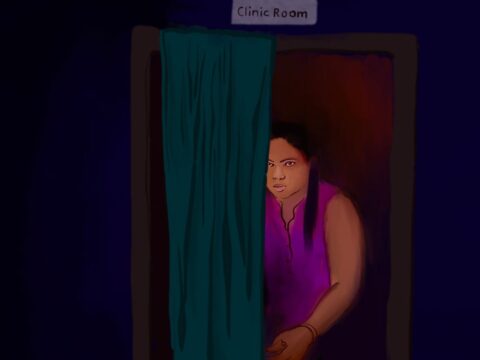
Locked public toilets, faraway blocks, curtained cubicles, a lack of privacy for bathing or sanitary disposal, night-time treks to railway tracks – are all daily hurdles for girls from migrant families in Patna’s slums.
Neither the darkness nor the trains whistling past at intervals are as unsettling as the sense that a man is watching.
“At night, the only toilet available is the railway tracks,” says 17-year-old Neetu Kumari.
Neetu lives in the Ward Number 9 slum colony in the Yarpur locality of south-central Patna. At the centre of this cluster of houses is a cemented square with a row of taps where two men, stripped down to the basics, are soaping themselves vigorously. About a dozen boys are playing with the water, flopping over on the slippery floor, pulling one another down, shrieking with laughter.
Around 50 metres away, a toilet block – the only one in this colony – stands unused, every one of its 10 cubicles locked, the handover of this public amenity to the community delayed by the pandemic. A family of goats lounges on the two steps to the elevated block. Behind, on the railway tracks, are heaps of garbage. The closest functioning public toilet is a 10-minute walk away, and some choose to cross the tracks to a toilet at the other end of Yarpur – also a 10-minute trudge.
“The boys do it anywhere, any time. The girls use the tracks only at night,” says Neetu, a first-year BA student. (All names in this story have been changed) She considers herself luckier than other girls of her locality – during the daytime, she can use the toilet in her aunt’s house, some 200 metres away.
“Also, we have two rooms at home, one in which my younger brother sleeps and one for my mother and me. So at least I have a private place to change pads in the house,” Neetu says. “Many other girls and women wait all day to change their napkins on the railway tracks at night – in the darkest section.”
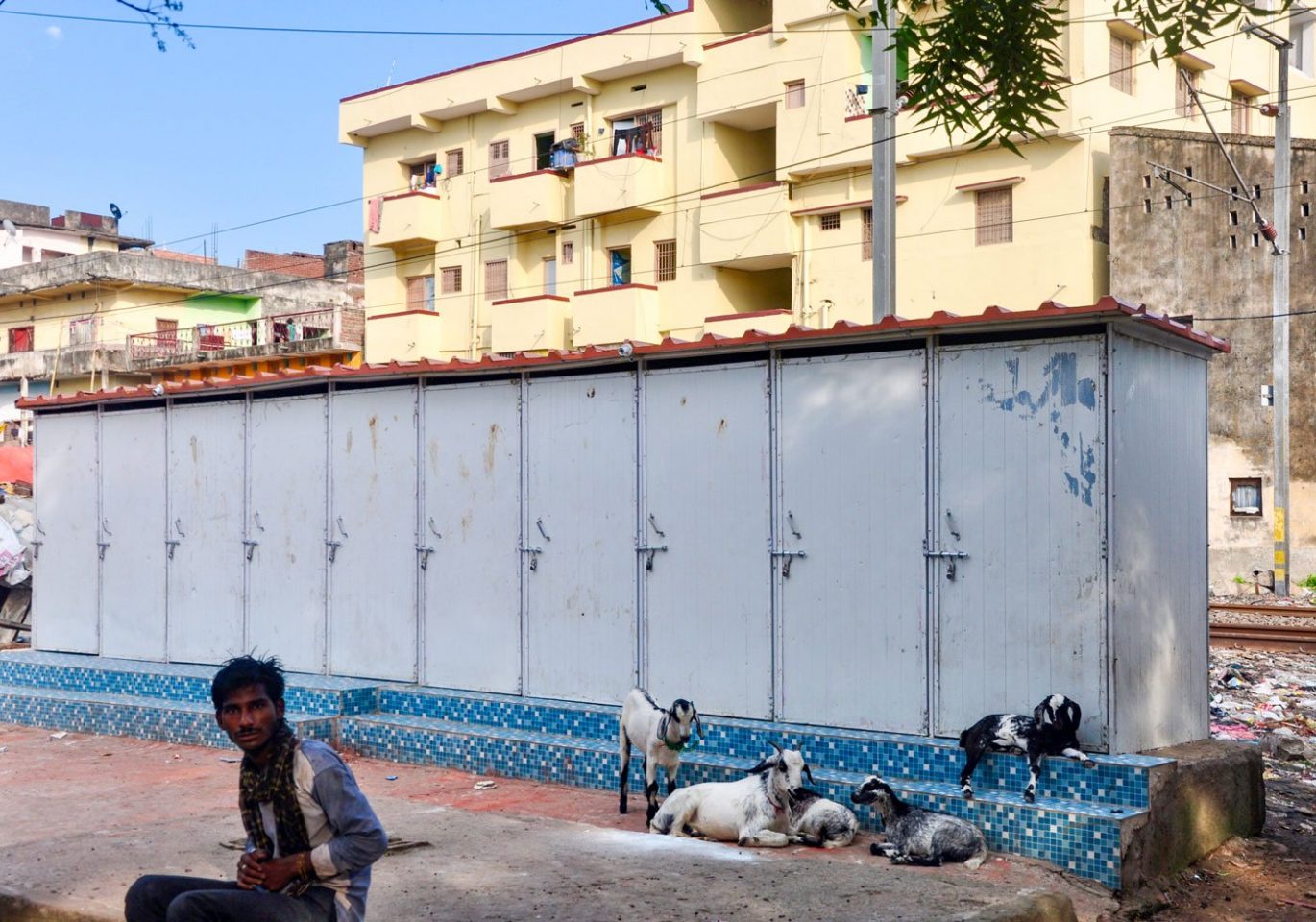
A public toilet block – the only one in this colony – stands unused, its handover to the community delayed by the pandemic
Her colony, the smaller Ward No 9 slum, and the adjacent larger Yarpur Ambedkar Nagar, are home, the residents here estimate, to around 2,000 families, mostly labourers, and many second-generation Patna residents like Neetu. Most of the families migrated here from different parts of Bihar to find work in the city decades ago.
In Yarpur Ambedkar Nagar, the women say they have for long used sanitary napkins, but due to the pandemic, loss of livelihoods and financial distress, a few have switched to using homemade cloth napkins. And most of the women – gathered in the verandah of a temple to talk to me – say they have access to toilets but these are in poor condition, lacking maintenance or repairs, and poorly lit at night. The toilets remain open at all hours, but the walk through the dark is a huge deterrent.
“It is only on the other side of the tracks, in Ward Number 9, that there are no toilets at all,” says Pratima Devi, 38, who was earning Rs. 3,500 a month as a school bus assistant until schools closed in March 2020. Since then, she has had no work. Her husband, a cook at a restaurant, was laid off towards the end of 2020 as well.
The couple has been making a living selling samosas and other snacks from a cart along the main road leading into Yarpur. Pratima wakes up at 4 a.m. to cook a meal, make purchases, prepare for the day’s sales, then clean and make another meal for the family. “We don’t make the Rs. 10,000-Rs. 12,000 we used to earn earlier, so we have to spend carefully,” she says. Pratima is among the women in Yarpur who have stopped buying sanitary napkins, for now.
Neetu, the college student, lost her father, an alcoholic, a few years ago. Her mother works as a cook in a few households on Boring Road, a five-kilometre walk from the slum colony. Along with other small cleaning jobs, she manages to earn Rs. 5,000-Rs. 6,000 per month.
“About 8 to 10 houses on our side of the colony have toilets inside their house, everyone else uses the tracks or walks to different public toilets,” Neetu says. This includes her bua, aunt’s house – though these toilets have rudimentary drainage and are not connected to any sewerage lines. “Only the night hours are a problem for me. But I am habituated to it now,” she adds.

The Ward Number 9 slum colony in Yarpur: ‘At night, the only toilet available is the railway track’
On those nights when she has to use the railway tracks, Neetu stays alert for sounds of the train’s horn and the tell-tale vibration on the tracks long before it arrives. Over the years, she has an idea of the frequency of trains along this section, she says.
“It is not safe and I wish I didn’t have to, but what is the alternative? Many girls and women also change sanitary napkins on the tracks, in the darkest section. Sometimes it feels like the men are always watching us,” she says. Washing is not always possible either, she adds, but at times, if there is enough water stored at home, she carries a pail.
Though she mentions the sense of being watched, neither Neetu nor the other young women and girls speak of any instances of sexual harassment en route to the toilets. Do they feel safe going there? Like Neetu, all of them say they are used to it and usually go in pairs or in groups as ample caution.
Neetu’s mother stopped buying sanitary napkins for a few months during the pandemic. “But I told her it’s essential. We buy them now. Sometimes packs of pads are handed out by NGOs too,” Neetu says. But how and where to discard the used pad discreetly remains a problem. “Many girls just leave these in public toilets or on the railway tracks because it’s awkward to walk out with a wrapped little package searching for a bin,” she adds.
Neetu herself either discards her used sanitary napkins in the garbage truck if she catches them at the right time, or walks to a large garbage bin that is at the other end of the Ambedkar Nagar slum. If she doesn’t have time for this 10-minute walk, she throws it on the tracks.
Left: Neetu’s house is located alongside the railway track. Right: Women living in the colony have to wash and do other cleaning tasks on the unpaved street
About three kilometres from Yarpur, on Sagaddi Masjid Road behind Haj Bhawan in south-central Patna, is a long row of semi- pucca houses built on both sides of an open drain. Here too the residents are long-time migrants to the city. Many of them return to families and homes in Begusarai, Bhagalpur or Khagaria districts for holidays, weddings or other occasions.
Pushpa Kumari, 18, is among those who live along the lower embankment. “ Yahaan tak paani bhar jaata hai ,” she says, holding her palms at her hip to indicate the water level when it rains heavily. “The drain overflows and floods our homes and toilets.”
Most of the roughly 250 houses here have a toilet each outside, built by the families, at the edge of the drain. Waste from the squatting toilets empties directly into the fetid waters of the two-metre-wide open drain.
Soni Kumari, 21, who lives a few houses away, says that during the monsoon months, sometimes a whole day goes by before the drain water recedes from the toilet and she can use it. Meanwhile, she has no option but to just wait.
Her father, who belongs to a landless family in Khagaria district, is a sanitation worker on contract with the Patna Municipal Corporation. He rides a garbage vehicle and walks into bylanes to collect trash in a large bin. “He worked right through the lockdown. They [his team] were given masks and sanitiser and told to go to work,” says Soni, who has just started the second year of her BA degree. Her mother works as a nanny in a nearby household. Their monthly household income is around Rs. 12,000.
In their colony by the open drain, each toilet stands in front of a house and is used only by its occupants. “Ours is in poor condition, the slab fell into the drain one day,” says Pushpa, whose mother is a homemaker, and her father, a mason and construction labourer, has been out of work for several months.
Left: Pushpa Kumari holding up the curtain to her family’s toilet cubicle. Right: In the Sagaddi Masjid Road colony, a flimsy toilet stands in front of each house
The toilets are tiny cubicles, made of asbestos or tin sheets held together with bamboo poles and bits of material – a discarded political banner, a plank of wood, some bricks. Inside is a ceramic squatting bowl – many of these are broken, chipped or stained – built on a slightly raised platform that in some toilets has given way. The cubicles don’t have doors – grubby cloth curtains offer a bare measure of privacy.
Just metres away from the first houses of the slum, almost at one end of the Sagaddi Masjid Road, is a government primary school. Outside this building are two toilets, locked like the rest of the school, since the start of the pandemic in March 2020.
The residents of this colony collect water from a series of public taps nearby, which are also bathing areas. Some women bathe in the space at the back of their houses with varying levels of privacy accorded by curtains and corners. Many of the girls and young women I spoke to have to bathe outside their doorstep or at the public tap, in groups, fully clothed.
“Some of us carry the water to the corners behind our homes to bathe. There is a little more privacy there,” says Soni.
“Adjust kar lete hain ,” Pushpa says, about bathing in the open. “But there’s no escaping the walk from the water tap to the toilet,” she adds, laughing. “Everybody knows you’re headed to do your business.”
Left: During the monsoon, sometimes drain water recedes from the toilet after an entire day. Right: Residents use public taps, which are also bathing areas
The only other source of water is the few chapakals , or handpumps, scattered across the slum. The same water (from the taps and handpumps) is used for all household purposes including cooking and drinking. Nobody boils the water, the girls say, though NGO volunteers and school teachers have been advising them about safe drinking water.
Sanitary napkins are the norm, and very few girls have had to use cloth, they say, though there were some difficulties in accessing shops during the lockdown. Many girls say their mothers have always bought the pads for them, though the older women themselves used cloth.
Often, used sanitary napkins go into the open drain where they occasionally surface days or weeks later, separated from their polythene or paper wrapping. “We’ve been taught [by NGO volunteers] to dispose of properly wrapped pads in the municipal garbage vehicle, but sometimes it’s embarrassing to walk with a pad, even if it’s wrapped very well, and throw it into the garbage with all the men watching,” says Soni.
Giggles and laughs break out among the group of girls – gathered in a local community hall to talk to me – and more accounts and anecdotes emerge. “Remember that time last monsoon when we didn’t eat for a day so that we wouldn’t have to use the flooded toilet?” asks Pushpa.
Soni, who wants to get a job after graduating “so that my parents don’t have to do the work they do now” says that while they have managed access to education, to some healthcare and other facilities, their persistent hurdle remains sanitation: “Toilets in the slum are girls’ biggest problem.”
Reporter’s note: My sincere thanks to Diksha Foundation for help and inputs while doing this story. The Foundation (along with UNFPA and the Patna Municipal Corporation) works with women and children in slums across Patna city on sanitation and other issues.
PARI and CounterMedia Trust’s nationwide reporting project on adolescent girls and young women in rural India is part of a Population Foundation of India-supported initiative to explore the situation of these vital yet marginalised groups, through the voices and lived experience of ordinary people.
Want to republish this article? Please write to zahra@ruralindiaonline.org with a cc to namita@ruralindiaonline.org

